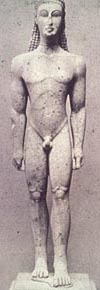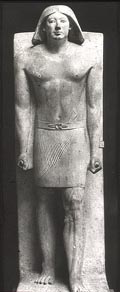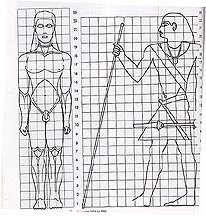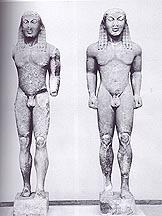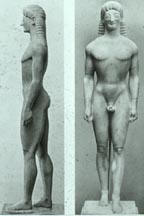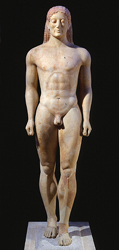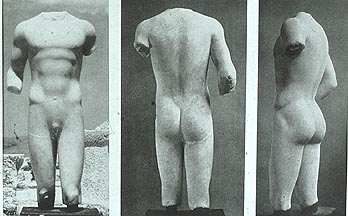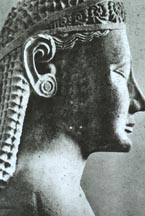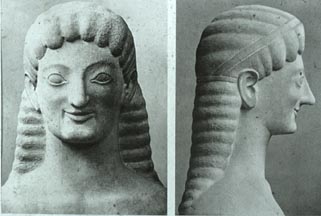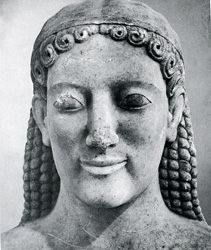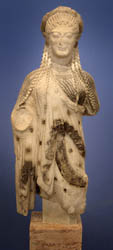Art Home | ARTH Courses | ARTH 200 Assignments
Archaic Greek Kouros
As mentioned in the video from the series How Art Made the World, a critical moment in the history of Greek was the creation of monumental sculpture. This occurred around the year 600 BCE. Before this point, the figure in Greek art was limited to small scale figurines like the figure of a youth from about 625 BCE found at Delphi.
The creation of large scale sculpture occurred almost overnight in different areas of the Greek world. There is not the evidence to explain the transformation as occurring internally within Greek culture, but as mentioned in the video, the most likely explanation is to see it as due to outside influence. The most plausible explanation is through Egyptian art. The establishment of Greek trading colonies in the Nile Delta region as a reward for the Greek mercenary's help of the Pharaoh Psamtik in consolidating his authority in Egypt is the most likely point of contact. A comparison of an Egyptian statue and an early Greek statue from around 600 BCE provides visual evidence to support this relationship.
In your journal, write down as specific a list as possible as to what you see as the meaningful similarities of these two works to justify the conclusion about the relationship of Egyptian and Greek art. Note that it is not enough to say that the same pose is found in both. As mentioned in the video, the Egyptian artists used a standardized grid to lay out the figure. As demonstrated by the following illustration, art historians have demonstrated that the Greek artists probably used the Egyptian canon of proportions:
What is striking is that after the invention of this type that we call the Kouros (pl.=kouroi) or Boy, these figures are found in a wide variety of sanctuaries and cemetaries around the Greek world from the end of the seventh century to the first quarter of the fifth century BCE. Below is a small gallery of examples:
While there is a striking continuity of these figures produced over several generations, it is important to identify significant changes. In your journal, articulate the similarities and differences. The row of heads above are details from several of the earlier kouroi. Use these to define similarities and differences.
Scholars still debate as to what these kouroi represent. It for a long while was believed that these figures are representations of the god Apollo. A number of these were discovered in sanctuaries dedicated to Apollo, but others are associated with specific individuals. For example, the kouros from Anavysos has an inscription which identifies it as Kroisos. The inscription on its base has been translated as: "Stay and mourn at the monument for dead Kroisos whom violent Ares destroyed, fighting in the front rank." Like we saw in our discussion of Egyptian art, this challenges our expectations about representation. Can we see this as a portrait of "Kroisos"? What are our expectations about the nature of a portrait? In answering this question, we can gain insights into the different conception of reality in Greek culture. In your journal, respond to these questions.
In striking contrast to the kouros figure is the female equivalent, the kore figure (pl.=korai). While the male figure in Greek art from its inception was represented as nude, the female nude did not appear in Greek monumental art until the latter half of the fourth century BCE. The example below comes from the last part of the sixth century. It was found on the Athenian Acropolis:
For more korai figures see the linked page. Consider the implications of the contrast in treatment of the male and female figures in Archaic Greek art.
